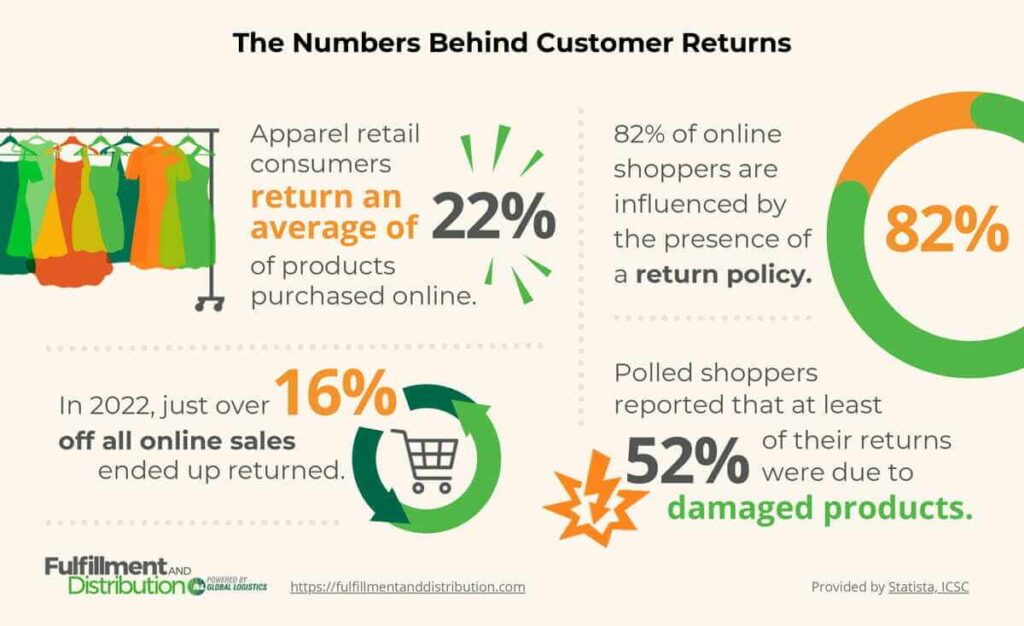
 Copy URL to Clipboard
Copy URL to Clipboard
Getting goods to customers in a way that is consistent and reliable is a key part of any business. That process is what retail logistics aims to accomplish, by helping you develop protocols for your supply chain from supplier all the way to customer.
Key Takeaways:
Let’s go through the basics of retail logistics and how streamlining this process can protect your supply chain and ultimately, your business.
Table of Contents
Retail logistics are all focused on all the processes used to manage merchandise from its point of origin to the consumer. Those processes will vary slightly depending on your business model.
Brick-and-mortar stores and ecommerce platforms, as an example, will have slightly different final mile needs. Everything else involved, from inventory management to transport needs, will be fairly standard.
The easiest way to see what will apply to you is to break down the processes into small logistical services.
Considering how many business functions actually count as logistics, narrowing down a few specifics is necessary to understanding what makes your supply chain possible. We’ll focus on three that most impact retail-style services.
Each of these has its own inner processes to account for its role in the supply chain. Even so, having a unified system to track everything at each stage is necessary for accountability.
Related: Inbound vs Outbound Logistics
For ecommerce businesses, having a workable solution for reverse logistics is especially necessary. Studies from the International Council of Shopping Centers in 2024 and research collected by Statista, have revealed trends in return policies that businesses need to consider.

These three logistics sub-types are technically the same whether you’re running a business to business (B2B) or business to consumer (B2C) organization. In the next sections, we’ll focus more specifically their application within retail and what challenges you’re likely to encounter.
Retail management and retail logistics are two sides of the same coin as far as business is concerned. One can’t function without input from the other.
Proper management of resources is necessary for logistics to be reliable and accurate. Reliable logistics make it easier to plan and manage a business’ needs. The main components being discussed here all work together and must be managed as parts of a whole.
A business must keep an accurate count of how much product they have and how quickly they go through it. Businesses tend to manage inventory in the following stages:
Your logistics processes at this time need to be focused on tracking and accuracy. Having too much in stock can be just as bad as having too little. One will cause your warehousing fees to go up, and the other may lose your customers due to long delivery times or limited availability.
Merchandise has to be physically moved from location to location. At the very least, a retail business needs to consider how their products will arrive to the distribution center. An ecommerce business will also need to consider final mile transportation to the end user.
A physical store must consider how they receive items. For instance, does their location have a loading dock for trucks to directly back into? If they don’t, they need to consider how they are getting items from the trailer into the building.
Carriers for the last mile will depend on what type of product you’re delivering. Small parcels are often sent out using carriers that specialize in those services and only handle items under a certain weight and size, typically about 70 pounds and small enough to be handled by one person.
Then there are your businesses shipping large, heavy items such as:
These need to be handled by carriers equipped to move large, heavy, and even awkwardly sized cargo. Making a poor choice at this stage is especially costly. If you thought reverse logistics for something like a broken coffee mug was bad, think of the headache (and expense) that would result from the aftermath of a dropped stair climbing machine or a grand piano.
Warehousing is necessary for any retail business that doesn’t operate on a direct-to-consumer strategy. A warehouse is often more than just a place where goods are stored, it’s the central hub of your in- and outbound logistics.
If you’re running your own warehouse, you’ll need to manage equipment, employees, packing services, and an inventory management system. All the moving parts make it the most costly part of a business and the most challenging.
The size and location of the warehouse also needs to be considered since it will affect lead times of incoming and outgoing shipments.
Many retail businesses, ecommerce as well as physical stores, find that outsourcing warehouse operations is far more efficient. These third party logistics (3PL) businesses operate out of established warehouses that already have the equipment, personnel, and technology to handle retail operations.
Related: Benefits of a 3PL for Retail Order Fulfillment
When you set out to streamline your retail logistics, it’s necessary to plan for potential roadblocks. Supply chains are surprisingly delicate things, requiring the cooperation of multiple parties.
Disruptions to your logistics services can come in several forms, but we’ll quickly review the most common.
Trying to overcome all of these challenges on your own while trying to run your logistics and business needs can be incredibly overwhelming. Outsourcing and delegating is necessary to grow your business successfully.
Leaving logistics to professional 3PLs frees up your time and focus so that you can manage the aspects of your business that you do know. Take that time to study your clients, the industry, and find products that will sell, all while having expert help.
If you’ve been struggling with finding a fulfillment service to provide you with retail logistics solutions, you’re in the right place. Fulfillment and Distribution operates warehouses across the country and partners with thousands of carriers for fulfillment services.
We offer clients:
Give us a call today at (866) 902-4262 to get started, or complete an online request form if you already know what services you’ll need.
